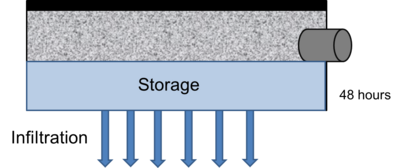
Difference between revisions of "Calculating credits for permeable pavement"
m |
|||
| Line 96: | Line 96: | ||
The annual TP credit (MTP-I) for infiltrated runoff is given by | The annual TP credit (MTP-I) for infiltrated runoff is given by | ||
| − | <math> M_ | + | <math> M_{TP_I} = V_{Annual} * EMC_{TP} * 2.72 </math> |
where: | where: | ||
| Line 105: | Line 105: | ||
Event based volume reduction TP credits are dependent on the volume reduction (V) and the filtration volume (VF) capacities of the BMP calculated above. | Event based volume reduction TP credits are dependent on the volume reduction (V) and the filtration volume (VF) capacities of the BMP calculated above. | ||
| − | The storm event based TP credit (MTP | + | The storm event based TP credit (MTP<sub>I</sub>) for infiltrated runoff is given by |
<math> M_{TP_I} = 2.72 * V / 43,560 * EMC_{TP} </math> | <math> M_{TP_I} = 2.72 * V / 43,560 * EMC_{TP} </math> | ||
Revision as of 14:36, 8 January 2015
This site is under construction. Anticipated completion date is March, 2015.
Credit refers to the quantity of stormwater or pollutant reduction achieved either by an individual BMP or cumulatively with multiple BMPs. Stormwater credits are a tool for local stormwater authorities who are interested in
- providing incentives to site developers to encourage the preservation of natural areas and the reduction of the volume of stormwater runoff being conveyed to a best management practice (BMP);
- complying with permit requirements, including antidegradation (see [1]; [2]);
- meeting the MIDS performance goal; or
- meeting or complying with water quality objectives, including Total Maximum Daily Load (TMDL) Wasteload Allocations (WLAs).
This page provides a discussion of how biofiltration practices can achieve stormwater credits.
Contents
Overview
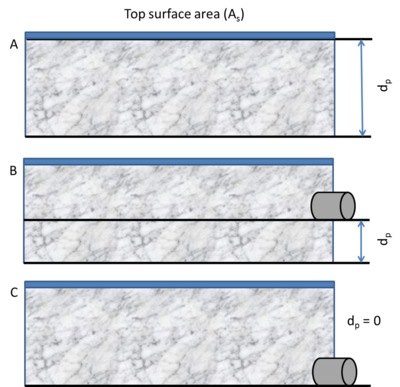
Permeable pavements with underdrains are a stormwater quality practice that allows runoff to pass through surface voids into an underlying stone reservoir/subbase for temporary storage and filtration before being discharged to a downstream BMP via an underdrain. Stormwater quantity may be achieved if storage and infiltration are allowed below the underdrain. The most commonly used types of permeable pavement are pervious concrete, porous asphalt, and permeable interlocking concrete pavers.
Pollutant removal mechanisms
Permeable pavements provide stormwater pollutant removal by reducing the volume of runoff from a site and the pollutant mass associated with that volume.
Location in the treatment train
Stormwater Treatment Trains are comprised of multiple Best Management Practices that work together to minimize the volume of stormwater runoff, remove pollutants, and reduce the rate of stormwater runoff being discharged to Minnesota wetlands, lakes and streams. Under the Treatment Train approach, stormwater management begins with simple methods that prevent pollution from accumulating on the land surface, followed by methods that minimize the volume of runoff generated and is followed by Best Management Practices that reduce the pollutant concentration and/or volume of stormwater runoff.
Permeable pavements are installed near the start of the treatment train as a method that directs the stormwater runoff to a subgrade storage area in order to minimize the volume and pollutant mass of stormwater runoff .
Calculating credits
This section provides specific information on generating and calculating credits from permeable pavement for volume, Total Suspended Solids (TSS), and Total Phosphorus (TP). Permeable pavement is also effective at reducing concentrations of other pollutants including nitrogen and metals. This article does not provide information on calculating credits for pollutants other than TSS and TP, but references are provided that may be useful for calculating credits for other pollutants.
In developing the credit calculations, it is assumed the permeable pavement practice is properly designed, constructed, and maintained in accordance with the Minnesota Stormwater Manual. If any of these assumptions is not valid, the BMP may not qualify for credits or credits should be reduced based on reduced ability of the BMP to achieve volume or pollutant reductions. For guidance on design, construction, and maintenance, see the appropriate article within the permeable pavement section of the Manual.
In the following discussion, the kerplunk method is assumed in calculating volume and pollutant reductions. This method assumes the water quality volume (WQV) is delivered instantaneously to the BMP. The WQV is stored as water ponded above the filter media and below the overflow point in the BMP. The WQV can vary depending on the stormwater management objective(s). For construction stormwater, the water quality volume is 1 inch off new impervious surface. For MIDS, the WQV is 1.1 inches.
In reality, some water will infiltrate through the bottom and sidewalls of the BMP as a rain event proceeds. The kerplunk method therefore may underestimate actual volume and pollutant losses.
Volume Credit Calculations
Volume credits are calculated based on the capacity of the BMP and its ability to permanently remove stormwater runoff via infiltration into the underlying soil.from the existing stormwater collection system. These credits are assumed to be instantaneous values entirely based on the capacity of the BMP to capture, store, and transmit water in any storm event. Instantaneous volume reduction, or event based volume reduction, of a BMP can be converted to annual volume reduction percentages using the MIDS calculator or other appropriate modeling tools.
Volume credits for a permeable pavement system are based on the porosity of the subbase and system dimensions, specifically the depth of the reservoir/ subbase below an underdrain, and the area of permeable pavement, and the bottom surface area. The volume credit (V) for the infiltration storage, in cubic feet, is given by
\( V = (A_O + A_B) / 2 * D_M * n \)
where:
- V = Volume reduction capacity of the permeable pavement system via infiltration (cubic feet).
- AO = Overflow surface area of the permeable pavement system. For installations without an underdrain this will be the top surface area. For installations with underdrains this will be the area of the permeable pavement system at the bottom of the underdrain (square feet).
- AB = Bottom surface area of the permeable pavement system (square feet).
- DM = Depth of the reservoir/subbase layer (engineered media). DM is the distance from the bottom of the permeable pavement material to the underlying soil subgrade (feet).
- n = Porosity of the reservoir/subbase (cubic feet per cubic foot).
Note that that entire porosity of the subbase layer is used to calculate the volume credit. This slightly overestimates the actual volume infiltrated since some water is held by the media after the runoff infiltrates. The water content after gravity drainage is complete, called field capacity, is less than 5 percent of total porosity for a permeable pavement system.
The volume reduction credit (V) can be converted to annual volume reduction percentage if the annual volume reduction quantity is desired. This conversion can be generated using the MIDS calculator or other appropriate modeling techniques. The MIDS calculator obtains the percentage annual volume reduction through performance curves developed from multiple modeling scenarios using the volume reduction capacity of the BMP, the infiltration rate of the underlying soils, and the contributing watershed size and imperviousness .
Water quality credit calculations
Water quality credits applied to permeable pavement can be calculated per rain event or based on total annual rainfall. Permeable pavement provides water quality benefits through infiltration of stormwater runoff. Because permeable pavement without underdrains assumes 100 percent infiltration for runoff captured by the BMP, water quality credits are represented entirely by the infiltrated credit and no additional credit is assumed for filtration.
Total Suspended Solids (TSS)
TSS reduction credits correspond directly with volume reduction. The water quality credits available for installation of permeable pavement depend on the design of the storage volume below the pavement. Total removal of Total Suspended Solids by permeable pavement is given by
\( M_{TSS} = M_{TSS_I} \)
where:
- MTSS =Annual or event TSS removal (pounds per event or pounds per year).
- MTSSI = Mass Total Suspended Solids removed by infiltration (pounds per event or pounds per year).
Annual pollutant reduction calculations are dependent on the annual volume reduction credit (VAnnual). The Annual TSS credit (MTSS-I) for infiltrated runoff is given by
\( M_{TSS_I} = 2.72 * V_{Annual} * EMC_{TSS} \)
where:
- MTSSI =Annual TSS removal from infiltrated runoff (lb/yr).
- VAnnual = Annual volume reduction credit calculated above (acre-ft).
- EMCTSS = Event Mean Concentration, concentration of TSS in the runoff. (mg/L). Note: if permeable pavement is not the upstream most BMP in the treatment train, EMCTSS should be dependent on the MTSS effluent (mg/L) from the next upstream tributary BMP.
- Factor of 2.72 used for conversion of acre-feet to liters and milligrams to pounds.
Event pollutant volume reduction calculations are dependent on the volume reduction capacity (V) of the BMP calculated above. The storm event based TSS credit (MTSS-I) for infiltrated runoff is given by
\( M_(TSS-I)=2.72*V/43,560*〖EMC〗_TSS \)
where:
- MTSS-I =Event TSS removal from infiltrated runoff (lb/event).
- V = Event volume reduction credit calculated above (cf).
- EMCTSS = Event Mean Concentration of TSS in the runoff. (mg/L). Note: if permeable pavement is not the upstream most BMP in the treatment train, *EMCTSS should be dependent on the MTSS effluent (mg/L) from the next upstream tributary BMP.
- Factor of 2.72 used for conversion of acre-feet to liters and milligrams to pounds. A Factor of 43,560 is used for conversion of volume from cubic feet to acre-ft.
Total Phosphorus (TP)
TP reduction credits correspond directly with volume reduction through infiltration. Removal is considered to be 100 percent for storm water that is captured and infiltrated by the BMP and 0 percent for storm water that is not captured by the BMP.
Total removal of Total Phosphorus Solids by permeable pavement is given by
\( M_{TP} = M_{TP_I} \)
where:
- MTP =Annual or event TP removal (lb/yr or lb/event).
- MTP-I =Annual or event TP removal from infiltrated runoff (lb/yr or lb/event).
Annual volume reduction TP credits are dependent on the annual volume reduction (VAnnual), as well as the annual runoff volume calculated above. The annual TP credit (MTP-I) for infiltrated runoff is given by
\( M_{TP_I} = V_{Annual} * EMC_{TP} * 2.72 \)
where:
- MTPI =Annual TP removal (lb/yr).
- VAnnual = Annual volume reduction credit calculated above (acre-ft).
- EMCTP = Event Mean Concentration of TP in runoff. (mg/L). Note: if permeable pavement is not the upstream most BMP in the treatment train, *EMCTP should be dependent on the MTP effluent (mg/L) from the next upstream tributary BMP.
- Factor of 2.72 used for conversion of acre-feet to liters and milligrams to pounds.
Event based volume reduction TP credits are dependent on the volume reduction (V) and the filtration volume (VF) capacities of the BMP calculated above. The storm event based TP credit (MTPI) for infiltrated runoff is given by
\( M_{TP_I} = 2.72 * V / 43,560 * EMC_{TP} \)
where:
- V = Event volume reduction credit calculated above (cf).
- EMCTP = Event Mean Concentration of TP in the runoff. (mg/L). Note: if permeable pavement is not the upstream most BMP in the treatment train, EMCTP should be dependent on the MTP effluent (mg/L) from the next upstream tributary BMP.
- Factor of 2.72 used for conversion of acre-feet to liters and milligrams to pounds. A Factor of 43,560 is used for conversion of volume from cubic feet to acre-ft.
Volume credits
A permeable pavement system without underdrains or with a raised underdrain achieves volume credits by allowing water below the underdrain to infiltrate into the underlying soil. Some infiltration will occur even in systems with underdrains.
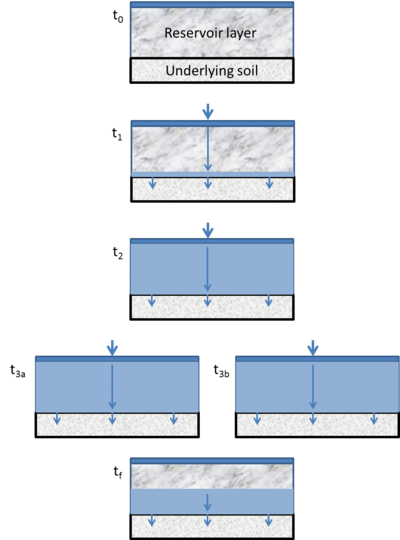
- Basis for volume credits
Volume credits for a permeable pavement system are a function of the dimensions of the system, specifically the depth of the subbase below an underdrain, the area of permeable pavement and the porosity of the subbase. Assuming all pore space is available for infiltrating stormwater, the volume credit (Vs) is given by
\(V_s = A_s d_p n\)
where
- As = the surface area of the permeable pavement system (square feet);
- dp = the depth of the reservoir layer, equal to the area from the bottom of the underdrain to the underlying soil (do not include the surfacing thickness)(feet); and
- n = porosity of the subbase(cubic feet/cubic feet).
The volume credit shown above assumes the entire pore space is available for water storage. Although field capacity provides a more accurate estimate of the water stored in a permeable pavement system, field capacity in these systems is assumed to be very low, likely 5 percent or less (see [3]).
Often, permeable pavement will be designed to meet a specific performance goal, such as the 1.1 inch Minimal Impact Design Standards (MIDS) goal for new development sites with no restrictions or a TMDL goal for phosphorus or TSS reductions. Specifications for designing permeable pavement systems, including a discussion of how to calculate the reservoir depth, are provided in the section covering design specifications for permeable pavement.
Infiltration rates for permeable pavement are initially on the order of hundreds of inches per hour, which is much larger than the intensity that can be produced by a rain event. Infiltration rates usually exceed one inch per hour even when the pavement is substantially clogged (Smith and Hunt, 2010). Sites that receive run-on from poorly maintained or disturbed areas had the lowest infiltration rate in a study by Bean et al. 2007. However, the infiltration rates at these sites were still high relative to rainfall intensities.
If a particular storm event exceeds the design storm event, the volume of water infiltrated will exceed the design volume of the permeable pavement system. This is the result of water infiltrating into the underlying soil as precipitation or runoff water continues to be delivered to the system after the design volume has been exceeded. For example, if the performance goal is 1.1 inches and the rain event is 2.0 inches, some of the excess 0.9 inches will be captured by the permeable pavement system. This additional volume infiltrated will be greater for long duration, lower intensity storms compared to a short duration high intensity event. On an annual basis, this additional volume is relatively small.
In a system with an underdrain at the bottom, water will infiltrate at a rate dependent on the underlying soil. The volume infiltrated is equal to the infiltration rate multiplied by the time that infiltration occurs. The length of time for a system to drain is controlled by the spacing of underdrains.
Models and calculators for calculating permeable pavement volume credits
The models and calculators discussed below are widely utilized within the stormwater community and are therefore appropriate for calculating volume credits provided the model assumptions are met and the permeable pavement is properly designed, constructed and maintained.
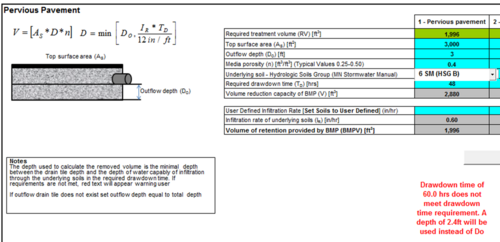
Minimal Impact Design Standards (MIDS) calculator
The Minimal Impact Design Standards (MIDS) calculator provides a BMP volume credit based on storage within the reservoir layer (subbase) below the permeable pavement. To calculate the storage volume credit, the design runoff volume needs to be calculated by multiplying the design runoff depth by the new impervious surface area. The Minimal Impact Design Standards (MIDS) performance goal for new sites without restrictions calls for controlling runoff volumes equivalent to 1.1 inches times the new impervious surface. Combined impervious and receiving permeable pavement areas are considered as one practice in the MIDS calculator. Runoff from pervious areas may be routed to permeable pavement and receive credit in the MIDS calculator. Nutrient and sediment emissions must be minimized.
Calculator inputs include
- the area of the permeable pavement surface (square feet);
- the reservoir depth (feet)(also called outflow depth). If the user enters a reservoir depth that will not allow drainage within 24 or 48 hours, the model calculates a depth based on the subbase porosity and the underlying soil;
- porosity of the subbase;
- the underlying soil, which the user selects from a dropdown box (14 options plus an option for a user-defined infiltration rate); and
- the required drawdown time (hours), which the user selects from a drop down box (choices are 24 or 48 hours).
The user can specify an impervious area that contributes to the permeable pavement. The user can also route water through downstream BMPs.
Calculator output includes
- the BMP volume capacity (cubic feet);
- the required retention volume for the specified performance goal (cubic feet);
- the BMP volume credit (cubic feet);
- the untreated volume (cubic feet); and
- the percent water removed relative to the performance goal.
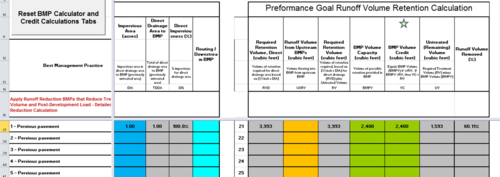
TSS credits
The water quality credits available for installation of permeable pavement depend largely on the design of the storage volume below the pavement and whether or not the runoff is filtered (through underdrain) or infiltrated. The credit for pollutant reduction corresponds directly with annual volume reduction. For example, if a system is designed to store and infiltrate the MIDS performance goal of 1.1 inches off impervious surfaces, it would result in an annual volume reduction of 91% for a site with HSG C subgrade soils, which corresponds to a 91% reduction in TSS. Designs that filter runoff with an underdrain at the bottom of the storage layer (on top of the subgrade) are less effective than infiltration designs. Runoff is filtered while flowing through the permeable pavement and the storage layer and out the underdrain.
Models and calculators for calculating permeable pavement TSS credits
The Manual does not provide specific recommendations for which values or models to use when calculating TSS credits for permeable pavement. The calculators and models discussed below are widely utilized within the stormwater community and are therefore appropriate for calculating TSS credits provided the model assumptions are met and the permeable pavement is properly designed, constructed and maintained.
Minimal Impact Design Standards calculator
If a system is designed to infiltrate the MIDS performance standard of 1.1 inches of runoff from the tributary impervious surfaces, it would result in a 91 percent annual runoff volume reduction from a site with hydrologic soil group (HSG) C soils (infiltration rate of 0.2 inches per hour). Annual pollutant load reductions for this example are approximately equal to the volume reduction. A site with HSG A soils (infiltration rate of 1.6 inches per hour) would result in higher annual reductions.
For designs with underdrains, the reductions are less because a portion of the water is captured by the underdrains before it can be infiltrated. Of the water intercepted and draining through the underdrain, 74 percent (with upper and lower 90 percent confidence bounds of 93 percent and 33 percent, respectively) of total suspended solids removal can be expected.
Since TSS credits are a function of the volume infiltrated, the design dimensions control TSS removal. Calculator inputs include
- the area of the permeable pavement surface (square feet);
- the reservoir depth (feet)(also called outflow depth). If the user enters a reservoir depth that will not allow drainage within 24 or 48 hours, the model calculates a depth based on the subbase porosity and the underlying soil;
- porosity of the subbase;
- the underlying soil, which the user selects from a dropdown box (14 options plus an option for a user-defined infiltration rate); and
- the required drawdown time (hours), which the user selects from a drop down box (choices are 24 or 48 hours).
The user can specify an impervious area that contributes to the permeable pavement. The user can also route water through downstream BMPs.
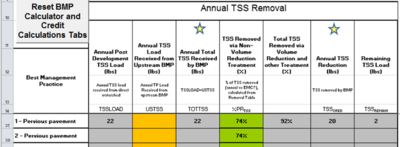
In calculating the TSS credit, the incoming TSS load is first reduced by 74%. This accounts for TSS removal in the case where an underdrain is at the bottom of the permeable pavement system. If an underdrain is suspended above the bottom of the design, then additional reduction in TSS loading will occur as a result of infiltration below the underdrain.
Calculator output includes
- annual post development TSS load in pounds, calculated by multiplying an event mean concentration (EMC) of 55.40 mg/L by the area contributing to the pavement. This area equals impervious surfaces discharging to the permeable pavement plus the direct precipitation onto the pavement;
- TSS removed via non-volume reduction treatment, equal to 74% of the incoming TSS load;
- Total TSS removed via volume reduction and other treatment, given as a percent of incoming TSS;
- Annual TSS reduction in pounds; and
- remaining TSS load, in pounds.
For an example with discussion, see the screen shot on the right.
Literature review on TSS reductions for permeable pavement
This section provides links to research and data on removal of TSS for permeable pavement. Users should be aware of assumptions and limitations associated with data presented in these reports or databases.
- New Jersey Stormwater BMP Manual. 2004. Standards for pervious paving systems. Chapter 9.7.
- Chris Brown, Angus Chu, Bert van Duin,and Caterina Valeo. 2009. Characteristics of Sediment Removal in Two Types of Permeable Pavement. Water Qual. Res. J. Can. 2009 · Volume 44, No. 1, 59-70
- North Carolina Department of Environment and Natural Resources. Water Quality Division. 2012. DWQ Stormwater BMP Manual & BMP Forms. Chapter 18.
- New Hampshire Department of Environmental Services. 2008. New Hampsire Stormwater Manual. Appendix B.
Pollutants other than TSS and phosphorus
In addition to TSS and phosphorus, permeable pavement can reduce loading of the following pollutants:
- Metals such as copper and zinc
- Nitrogen
- Hydrocarbons
- Chloride (indirectly by reducing the amount of road salt applied)
- Oxygen demand
Specific credits and methods for calculating credits are not provided in this section. Information on removal of these pollutant by permeable pavement systems can be found at the following links.
- [4] - information on zinc, copper, lead, nitrate, Kjeldahl nitrogen, and total nitrogen
- [5] - information on total nitrogen, heavy metals, and hydrocarbons.
Related articles
- Overview for permeable pavement
- Types of permeable pavement
- Design criteria for permeable pavement
- Construction specifications for permeable pavement
- Assessing the performance of permeable pavement
- Operation and maintenance of permeable pavement
- Calculating credits for permeable pavement
- Additional considerations for permeable pavement
- References for permeable pavement
- Fact sheets for permeable pavement
